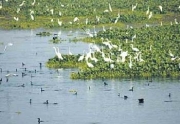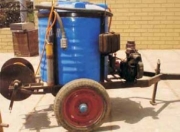India
Preparation of City Sanitation Plans for select cities in India - Consultation workshop organised by MoUD, MoEF and GTZ-ASEM (April 2010)
Posted on 14 Dec, 2010 09:37 PMA two day workshop was conducted on 15-16 April 2010 at Bangalore by GTZ-ASEM and supported by the Ministry of Urban Development (MoUD) and the Ministry of Environment and Forests (MoEF) regarding preparation of City Sanitation Plans.
The Ministry of Urban Development (MoUD) has undertaken the preparation of the City Sanitation Plans (CSPs) under the National Urban Sanitation Policy (NUSP) since the year 2008.
Groundwater quality in shallow aquifers of India – A report by the Central Ground Water Board
Posted on 14 Dec, 2010 07:54 AMThis report by the Central Ground Water Board entitled ‘Ground Water Quality in Shallow Aquifers of India’ is an outcome of the follow up of one of the important recommendations of the second meeting of the Advisory Council on Artificial Recharge to Ground Water during September 2007. It attempts to summarize various aspects of groundwater quality in the shallow aquifers in the country with special reference to six parameters viz. salinity, chloride, arsenic, fluoride, iron and nitrate.
Uniform protocol on water quality monitoring by Ministry of Environment and Forests (2005)
Posted on 13 Dec, 2010 07:32 PMThis deals with the Central Government’s order on “Uniform Protocol on Water Quality Monitoring Order” in June 2005 in exercise of the powers conferred by section 3 of the Environment (Protection) Act, 1986. Due to the deterioration of the river water quality, health and livelihood of the downstream people are being severely affected and concerns are raised time and again.
An introduction to sanitation technologies - Video from Water for People
Posted on 13 Dec, 2010 12:44 PMWe often get asked about toilets— what is the difference between a VIP and an improved pit latrine? What is the actual technology that supports Ecological Sanitation? Good questions, and so we are introducing short videos on different types of toilets.
Misguided debate continues to shape sanitation crisis
Posted on 13 Dec, 2010 12:04 PMA study is now circulating about how more people in India have access to cell phones than latrines. This lit up the blogosphere and Twitter – sector professionals and advocates are both dumbfounded and outraged that something so central to health and development as a toilet is being numerically lapped by something so trivial/consumerist as a cell phone. This affront has led to yet further calls for "action": more money for toilets and greater commitments to sanitation provision from aid agencies, governments, and NGOs who too often prioritize water over sanitation.
Unregulated sand mining threatens Indian rivers - Ground report article
Posted on 11 Dec, 2010 03:47 PMArticle and Image Courtesy: Ground Report
Many in India, perhaps, are not able to foresee how lack of governance, virtually, in every sphere is going to hit them in not too distant future. Take for instance mining. Illegal mining of mineral resources, with generous help of political and bureaucratic big wigs, is so rampant that not only are the country’s precious natural resources being purloined in a big way, its forests are being clean-felled, land degraded and its rivers threatened with extinction.
Water conservation - A viable option to improve water availability - Solution Exchange paper
Posted on 11 Dec, 2010 12:16 PMThis paper from the recommended documentation section of the Solution Exchange for the Water Community Discussion Summary on the preparation of the strategic plan for rural drinking water by the Department of Drinking Water Supply, Ministry of Rural Development, is directed at stakeholders, planners, managers and consumers.
The paper argues on the importance of water conservation in the context of the increasing water shortages that the country has been facing in recent years because of expansion of irrigated areas and rapid industrialisation.
The article argues that water conservation practices need to be encouraged and improved through research, effective regulations, information dissemination and incentives to the end user and more emphasis needs to be placed on adequate coverage, quality monitoring and collection of field level data.
Mitigation and remedy of groundwater arsenic menace in India: A vision document by NIH and CGWB (2010)
Posted on 10 Dec, 2010 11:52 PMThis document, an outcome of the joint efforts of NIH and CGWB gives a detailed outline emphasizing the gaps, focal areas of research, immediate measures to be taken up to provide arsenic safe potable water to the people in the arsenic vulnerable areas, other activities to be initiated for attaining a logical conclusion of the arsenic problem and also to develop a roadmap delineating as to how the suggested activities could be initiated, coordinated, undertaken, including framing out a budget estimate to fulfill those activities.
The Wetlands (Conservation and Management) Rules by Ministry of Environment and Forests (2010)
Posted on 10 Dec, 2010 07:27 AM The Wetlands (Conservation and Management) Rules was notified in December 2010 by the Ministry of Environment and Forests to ensure better conservation and management and to prevent degradation of existing wetlands in India. Wetlands are critical for human development and wellbeing, especially in India where a large number of people are dependent on them for drinking water, food and livelihood. Despite their immense importance, wetlands are one of the most degraded ecosystems globally.
The Wetlands (Conservation and Management) Rules was notified in December 2010 by the Ministry of Environment and Forests to ensure better conservation and management and to prevent degradation of existing wetlands in India. Wetlands are critical for human development and wellbeing, especially in India where a large number of people are dependent on them for drinking water, food and livelihood. Despite their immense importance, wetlands are one of the most degraded ecosystems globally.
Farm Innovators – A compilation by the Indian Council of Agricultural Research (2010)
Posted on 09 Dec, 2010 09:23 PM This publication by ICAR on “Farm Innovators-2010” brings in a paradigm shift towards participatory technology development. Apart from innovations and scientific package of practices developed and transferred from R&D institutes, innovations in the form of grassroot level technologies and methodologies developed by some of the innovative farmers and rural youth have also been accepted across the system.
This publication by ICAR on “Farm Innovators-2010” brings in a paradigm shift towards participatory technology development. Apart from innovations and scientific package of practices developed and transferred from R&D institutes, innovations in the form of grassroot level technologies and methodologies developed by some of the innovative farmers and rural youth have also been accepted across the system.